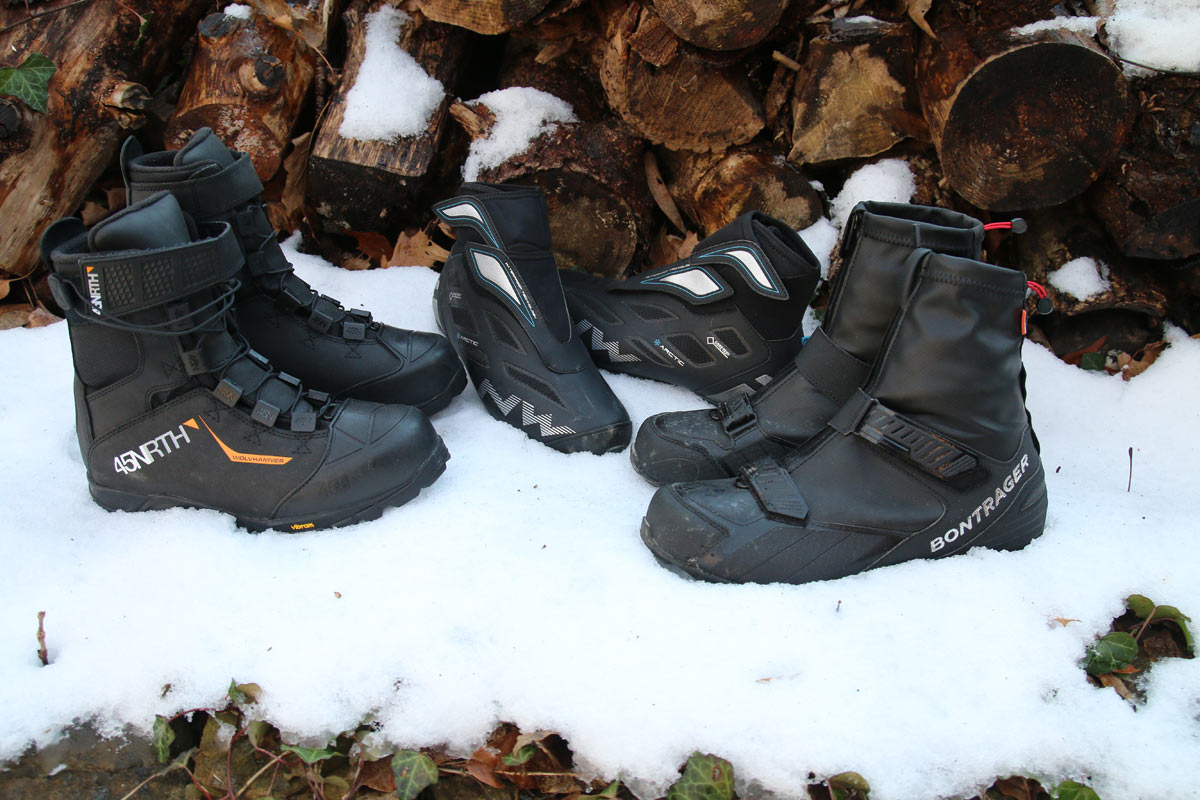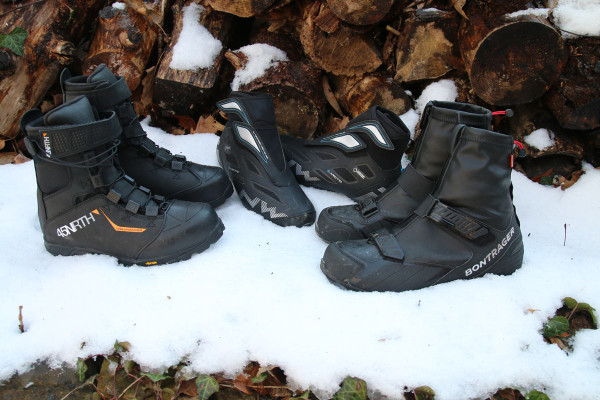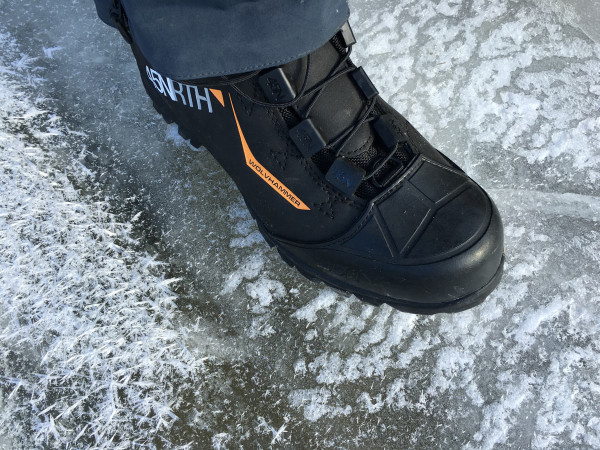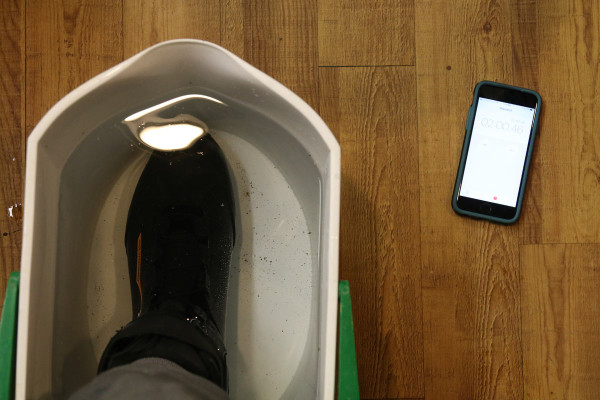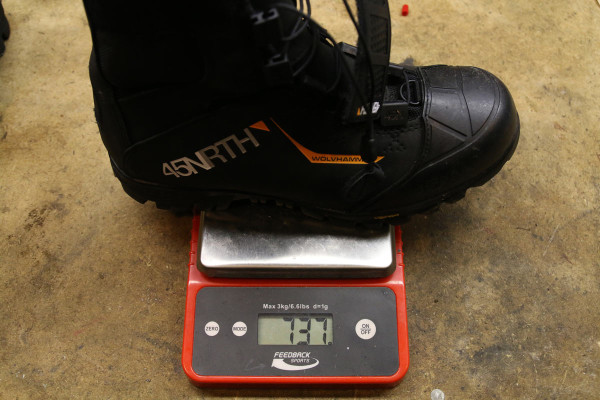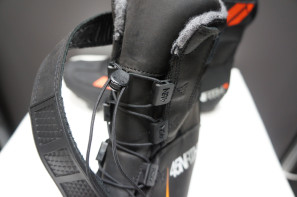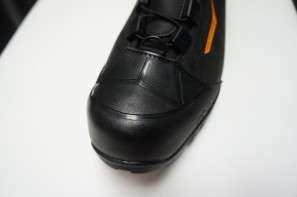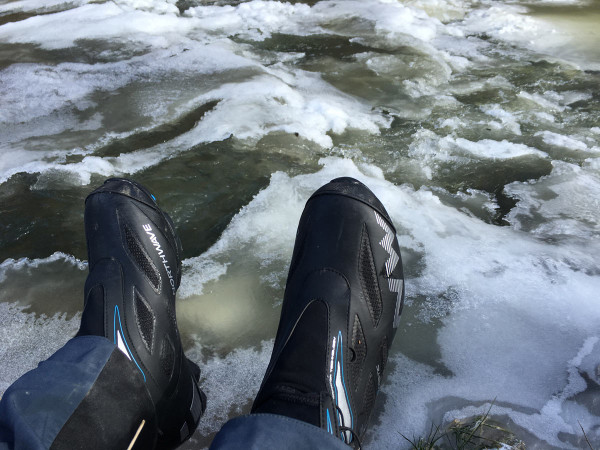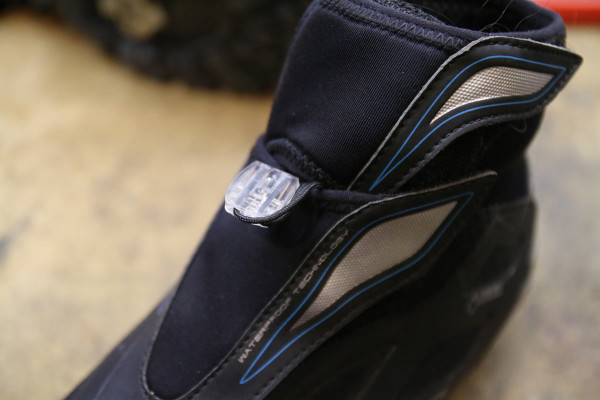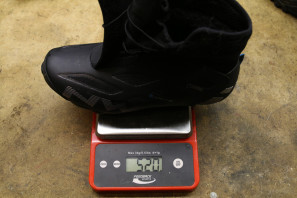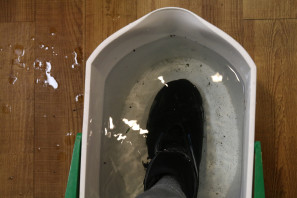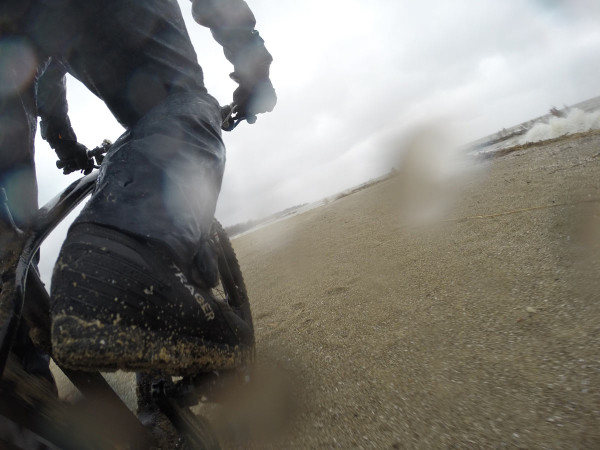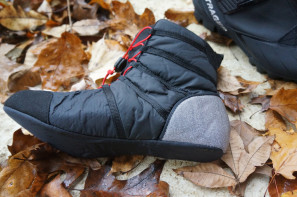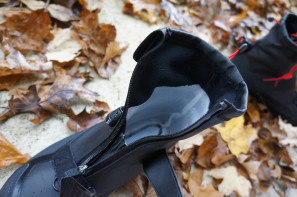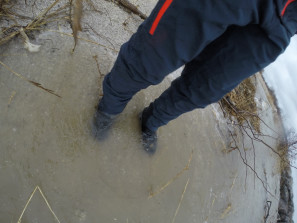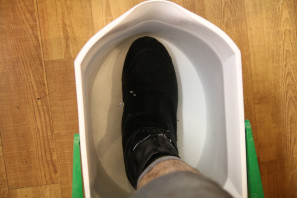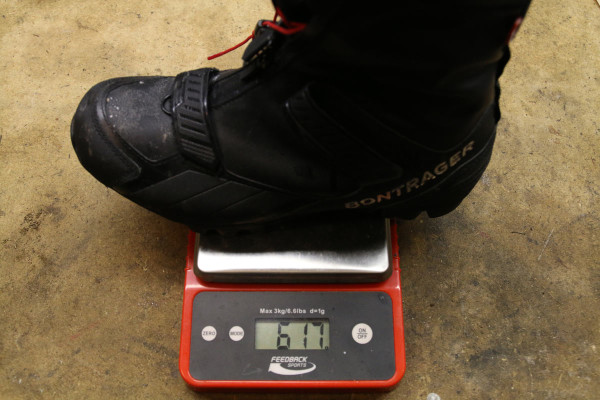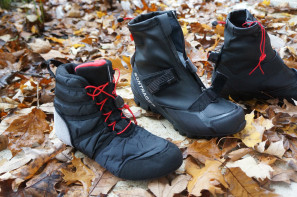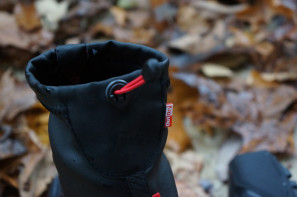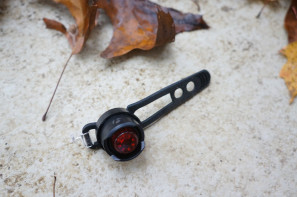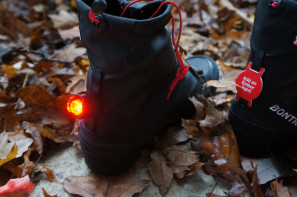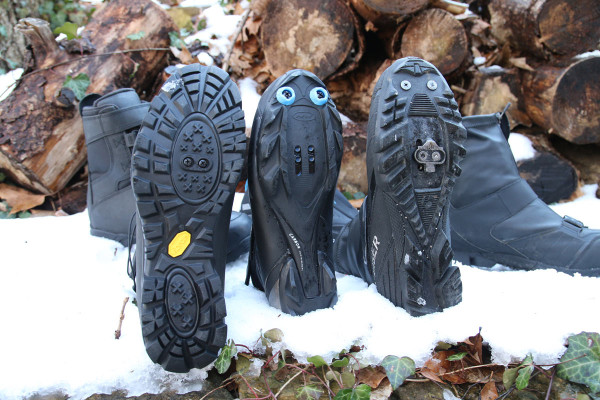When I was really young, going out to play in the snow meant stuffing my feet into plastic bags and then into my shoes. I still love playing in the snow just as much, but fortunately my footwear is a little more, uh, comfortable.
Nothing puts a damper on a winter ride quite like wet, cold feet. At best, you tough it out through a miserable ride. At worst – the ride is over, or you risk frost bite if the conditions are right. Shoe covers work, but they’ll only take you so far. Hardly waterproof thanks to the giant openings in the bottom, they also seem to all suffer from the same fate – torn and floppy after one good season.
Yes, winter riding boots will keep your feet warm and your summer shoes in great shape, but which ones should you get? There are more options than ever, but this time we’re taking a look at the new 45NRTH Wölvhammers, Bontrager Old Man Winters, and the Northwave Celsius Arctic 2 GTX…
Of all the boots in this roundup, the 45NRTH Wölvhammers are the most burly. They feel like they would be equally at home hiking through the woods to do your best impression of a lumberjack as they would be pedaling through the frozen tundra. Because of that, they seem to be uniquely suited towards more adventurous winter riding. Sold with plugs for flat pedal use, the soles are equally aggressive offering sure footedness in most conditions. Feeling quite durable, these would be my choice for rides with a lot of bushwhacking or other situations where the ruggedness of your footwear may be called into question.
Likely due to that construction, the Wölvhammers were not only the warmest, but also the most waterproof boots on test. Using a bucket of water, I put on each boot and stepped into the same water level. My plan was to time it until my foot was completely wet, but after 3 minutes, only my toes were wet on the Wölvhammers. At two minutes in, my foot was still completely dry meaning you should be able to cross streams with confidence that your feet will stay dry by the time you reach the other side. For testing their warmth, all three boots were used back to back to back on two different days – one at 0°f and one at about 10ºf. Regardless of sock choice, the 45NRTH Wolvhammers were the clear winner in warmth. Not surprisingly, the Wölvhammers were also the heaviest in the group at 737g per boot (with SPD cleat). Their redesign cut down on weight, but they’re still on the heavier side.
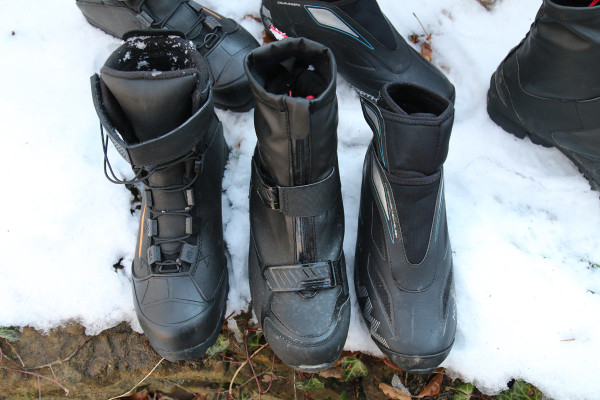
On the flip side, I found that the heavy duty construction made them less ideal for fast pedaling. Personally, I struggled to find the ideal fit – first in the actual size and then in the adjustment of the boot itself. After following the instructions on 45NRTH’s site I ended up with a 41 – smaller than the usual 41.5-42 I normally wear. Eventually I ended up with a 43 which were just a touch too big, but about right for really thick socks. Ideally, I should probably be in a 42, but the toebox of the Wölvhammer is narrow enough to warrant a size up. Once settled on size, I found the speed lace system to end up too loose around my foot and too tight around the ankle. Due to how tall the Wölvhammer is, for me it would be best to have two separate lace systems, one for the lower part of the boot, and one for the upper. Ultimately, the Wölvhammer will come down to fit – if they fit you well, they are an awesome boot.
Speaking of boots for going fast – the Northwave Celsius Arctic 2 GTX would be a good choice. Northwave’s pedigree of making fast, sleek shoes shows in the GTX as it was the lowest volume boot of the three. The GTXs also offer the best pedaling efficiency with a carbon reinforced Jaws sole, something you can actually feel. However, there seems to be no replacement for loft and it shows with the GTX offering the least warmth of all three. While Northwave rates these down to -25°c (-13ºf), for my feet that’s a little generous. They were great down to 10ºf, but below that they got a little uncomfortable. However, if you’re pedaling hard and putting off a lot of heat (and have warmer feet than me) you might actually be comfortable in the GTX below zero. As the lightest boot in the test, each boot came in at 520g (with SPD cleat).
Using a combination speed lace system with two velcro covers, the GTX boots are very quick to get on. Their biggest negative comes from how the velcro straps push the speed lace latch into your ankle. I was unable to find a position for it under the velcro tabs that was comfortable as it dug into my shin when pedaling. I ended up sticking it outside the velcro covers which isn’t how it’s intended, but it was the best answer for me.
On the bucket test, the GTX boots performed quite well as you would expect from a pair of boots with a Gore-tex membrane. Their weak point as expected comes from the velcro closures. As soon as the water gets to the first joint in the velcro, it will start to seep in. However, it did take at least 1:24 until the top of my foot started to get wet. While the GTX boots have a lower cuff than the Wolvhammers, they do a good job of keeping water out for a short period of time.
It’s worth pointing out that the GTXs, are the only boot out of the three that do not come with bolt-on tread blocks to use with plat form pedals.
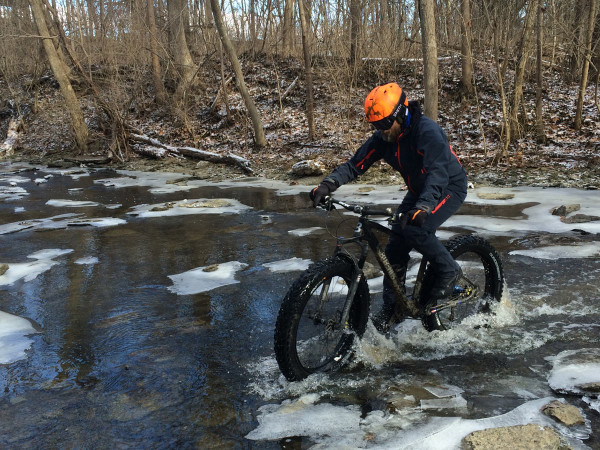
The Bontragers were a surprise. When we were approached to try out their new winter boot, I sort of expected something similar to other boots with the Bontrager logo attached. What we got was a fairly unique boot in a very good way.
Most winter boots suffer from the same issue – in order to be warm, they usually give up pedaling performance due to the heavier construction. Some times that means riders experience a lot of heel slip, other time it just means the fit is not very comfortable. Due to a very flexible upper and a well placed compression strap, the Bontrager Old Man Winter delivers a boot that is super warm, comfortable, and quite pedal friendly. To get there, the OMWs use a boot within a boot construction with a 200g 3M Thinsulate bootie that nests inside the outer shell. To keep the two from moving independently when pedaling, the bootie has a large area of “cat tongue” fabric that locks into the opposite wall of the outer boot and keeps your heel from moving.
While the OMWs stayed comfortably dry on the trail, the occasional creek crossing, and even submerged by a wave up to my ankles, they fared the worst on the bucket test, completely soaking through in just 24 seconds. The waterproof zipper is enough to shed water and snow on the trail, but when completely submerged it takes on water in a hurry. On the positive side, the OMWs came in just under the 45NRTH Wolvhammers in terms of total warmth, and take the prize for total comfort and pedaling performance. Sitting right in the middle, the OMWs came in at 617g per boot (with SPD cleat).
It should be mentioned that while the Wolvhammer and GTX are fairly easy to put on (important when you’re dancing around on frozen pavement at the trailhead trying to put on your boots), the OMWs are fairly difficult. Part of what keeps the boot warm and comfy is the 200g 3M Thinsulate bootie, but it also is difficult to keep from bunching up when you put it on. It does have a pull tab on the rear, but it isn’t attached to the outer boot so it can be tricky. Once your foot is inside though, a speed lace system pulls it snug (the best of the bunch), and I found the size of the speed lace tab to be small enough with enough room inside the outer boot that it was unobtrusive. There is also a pull cord on the cuff to keep out any snow.
The OMWs also deserve credit for attempting to increase rider visibility in the winter. They may not be offered in the Hi Viz color way of the Northwave boots, but the OMWs have a little velcro strap on the back that is meant for a Bontrager Ember light for each foot. Granted you have to buy the lights, but those concerned about visibility on their commute may appreciate this feature.
Perhaps proof there is no perfect boot, in spite of the few negatives for each model I would still recommend each of them depending on your intended use. If you’re into more rugged adventure riding (and assuming they are a better fit for you than me), the 45NRTHs seem like an excellent choice. For riders looking to spend more time racing during the winter and looking for a winter boot for cyclocross or just an SPD compatible road shoe (also available with an SPD-SL compatible sole), the Northwaves are the answer thanks to their light construction and sleek form. When it comes to general riding, those looking for the most comfort and flexibility when pedaling, the Bontrager OMWs are a great option, which are also probably my pick for a favorite among these three.
It’s a tough choice, but whatever you choose, you’ll be way better off than summer shoes and plastic bags.
